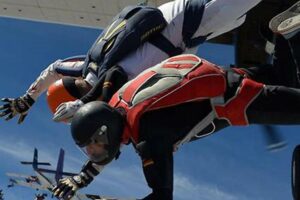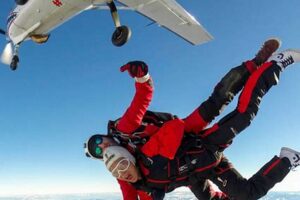Table of Contents
Skydiving, the act of leaping from a plane into the void, has gained immense popularity. A critical aspect of this activity revolves around the question, “How high up do you skydive from?” This inquiry pertains to the starting altitude from which skydivers initiate their descent. In practice, this altitude typically ranges from 8,000 to 15,000 feet above ground level.
Understanding the height of a skydive is crucial for several reasons. It impacts factors such as the time available for freefall, the minimum altitude for deploying the parachute, and the duration of the entire experience. Height also plays a significant role in safety, as higher altitudes provide a greater margin for error in case of equipment malfunctions or emergencies.
Historically, skydiving from higher altitudes was limited by aircraft capabilities. However, advancements in aviation technology have enabled skydivers to reach unprecedented heights. In 2014, Alan Eustace set a record by skydiving from the stratosphere at an altitude of 135,908 feet. This remarkable feat showcased the evolution of the sport and pushed the boundaries of human endeavor.
How High Up Do You Skydive From?
Understanding the altitude from which skydivers jump is crucial for safety, experience, and planning. Key aspects to consider include:
- Freefall Time
- Parachute Deployment Altitude
- Overall Experience Duration
- Safety Margin
- Aircraft Capabilities
- Weather Conditions
- Skill Level
- Record-Breaking Attempts
These aspects are interconnected. For instance, higher altitudes provide longer freefall times but require more time for parachute deployment. Weather conditions can impact aircraft capabilities and visibility, affecting the choice of jump altitude. Skill level influences the minimum altitude required for safe parachute deployment. Record-breaking attempts push the boundaries of altitude, showcasing technological advancements and human capabilities.
Freefall Time
Freefall time is a critical aspect of skydiving, directly related to the altitude from which one jumps. A higher starting altitude translates into a longer freefall duration, offering an extended period of exhilarating descent. Understanding the factors that influence freefall time is essential for planning and executing a skydive.
-
Altitude
The primary determinant of freefall time is the altitude from which the skydiver jumps. Higher altitudes provide longer freefall times, allowing for more time to experience the sensation of freefall and perform maneuvers. -
Body Position
The skydiver’s body position during freefall can also affect freefall time. A streamlined position, with the body held close to the center of gravity, reduces drag and allows for a faster descent, resulting in a shorter freefall time. Conversely, a spread-eagle position creates more drag, slowing down the descent and extending freefall time. -
Weight
A skydiver’s weight influences freefall time. Heavier skydivers experience greater gravitational pull, leading to a faster descent and shorter freefall time compared to lighter skydivers. -
Wind Speed and Direction
External factors such as wind speed and direction can impact freefall time. A tailwind, blowing in the same direction as the skydiver’s descent, can increase the speed of descent, reducing freefall time. Conversely, a headwind, blowing against the skydiver’s descent, can slow down the descent, extending freefall time.
These factors collectively determine the duration of freefall time, a key element in planning a skydive. Skydivers can adjust their jump altitude, body position, and other variables to achieve their desired freefall experience, whether it’s a brief adrenaline rush or an extended period of controlled descent.
Parachute Deployment Altitude
Parachute deployment altitude is a critical component of “how high up do you skydive from” as it directly impacts the safety and success of a skydive. The altitude at which a skydiver deploys their parachute is determined by several factors, including the type of skydive being performed, the skill level of the skydiver, and the prevailing weather conditions.
For recreational skydives, the typical parachute deployment altitude is between 5,000 and 7,000 feet above ground level (AGL). This altitude provides sufficient time for the skydiver to stabilize their freefall, perform any desired maneuvers, and prepare for landing. More experienced skydivers may choose to deploy their parachutes at higher altitudes, such as 8,000 to 10,000 feet AGL, to extend their freefall time. In contrast, skydivers performing high-altitude jumps, such as those from over 15,000 feet AGL, may need to deploy their parachutes at lower altitudes, around 3,000 to 4,000 feet AGL, due to the increased risk of hypoxia and decompression sickness.
Understanding the relationship between parachute deployment altitude and “how high up do you skydive from” is essential for skydivers of all skill levels. By carefully considering the factors that influence parachute deployment altitude, skydivers can make informed decisions that prioritize their safety and enjoyment during their skydives.
Overall Experience Duration
Skydiving experiences vary notably in duration, and one of the primary factors influencing this is the altitude from which the jump is made. Higher altitudes lead to longer overall experience durations, encompassing the time spent in freefall, parachute deployment, and descent to the landing area.
Consider a skydive from 10,000 feet AGL. The freefall portion alone may last for approximately 60 seconds, followed by several minutes of parachute descent. In contrast, a skydive from 5,000 feet AGL may result in a freefall time of around 30 seconds and a shorter descent duration. Thus, the choice of jump altitude directly affects the overall time spent in the skydiving experience.
The duration of the skydive experience is a critical consideration for participants. Those seeking an extended and thrilling freefall experience may opt for higher jump altitudes, allowing for more time to enjoy the sensation of freefall and perform maneuvers. Conversely, individuals prioritizing a shorter and less intense experience may choose lower jump altitudes.
Understanding the relationship between “how high up do you skydive from” and “Overall Experience Duration” empowers skydivers to make informed decisions that align with their preferences and desired outcomes. This understanding is essential for both recreational and professional skydivers, helping them plan and execute skydives that meet their specific goals and expectations.
Safety Margin
In skydiving, the concept of “safety margin” encapsulates a range of measures and considerations that prioritize the well-being of participants. Directly tied to the question of “how high up do you skydive from,” safety margin encompasses various facets that collectively contribute to a successful and enjoyable skydiving experience.
-
Equipment Redundancy
Skydiving equipment is meticulously designed with built-in redundancies. For instance, the main parachute is complemented by a reserve parachute, ensuring a backup option in case of any malfunctions.
-
Altitude Buffer
Jumping from higher altitudes provides a greater margin for error in the event of equipment issues or unexpected scenarios. This buffer allows skydivers more time to react and deploy their reserve parachutes if necessary.
-
Skill and Experience
Experienced skydivers possess a higher level of proficiency in handling emergency situations. Their familiarity with potential risks andof proper procedures contributes to a wider safety margin.
-
Weather Conditions
Favorable weather conditions, such as clear skies and calm winds, create a safer skydiving environment. By carefully assessing weather forecasts, skydivers can minimize risks and increase their safety margin.
Collectively, these facets of safety margin play a crucial role in mitigating risks and enhancing the overall safety of skydiving. By carefully considering “how high up do you skydive from” in conjunction with these safety measures, skydivers can make informed decisions that prioritize their well-being while pursuing the exhilarating experience of skydiving.
Aircraft Capabilities
The relationship between “Aircraft Capabilities” and “how high up do you skydive from” is a critical one, as the capabilities of the aircraft directly influence the altitude from which skydivers can jump. Higher-performance aircraft can reach greater altitudes, allowing skydivers to experience longer freefall times and more extreme descents. Conversely, aircraft with limited capabilities may restrict jump altitudes, impacting the overall skydiving experience.
One key aspect of aircraft capabilities in skydiving is climb rate. The rate at which an aircraft can ascend determines how quickly skydivers can reach their desired jump altitude. High-performance aircraft with powerful engines can climb rapidly, enabling skydivers to reach higher altitudes in a shorter amount of time. This is especially important for skydivers who wish to maximize their freefall time or perform complex maneuvers during their descent.
Another important factor is the aircraft’s ceiling altitude. The ceiling altitude is the maximum altitude that an aircraft can safely reach and maintain. This altitude is determined by a combination of factors, including engine power, wing design, and structural integrity. Aircraft with higher ceiling altitudes allow skydivers to jump from greater heights, resulting in longer freefall times and more exhilarating experiences.
In summary, the capabilities of the aircraft play a critical role in determining how high up skydivers can jump from. Higher-performance aircraft with faster climb rates and higher ceiling altitudes enable skydivers to reach greater heights, experience longer freefall times, and perform more complex maneuvers. Understanding the relationship between aircraft capabilities and jump altitude is essential for skydivers to plan and execute safe and enjoyable jumps.
Weather Conditions
The relationship between “Weather Conditions” and “how high up do you skydive from” is both critical and dynamic. Weather conditions can significantly impact the safety, feasibility, and overall experience of a skydive. Favorable weather conditions, such as clear skies, calm winds, and good visibility, provide an optimal environment for skydiving at higher altitudes.
One of the most important considerations is wind speed and direction. Strong or gusty winds can make it difficult or even dangerous to jump from higher altitudes. High winds can affect the accuracy of the landing zone, making it challenging for skydivers to land safely. Additionally, strong winds can cause the parachute to open prematurely, potentially leading to entanglement or other complications.
Visibility is another crucial factor. Poor visibility due to fog, clouds, or precipitation can make it difficult for skydivers to navigate and maintain visual contact with the ground. This can increase the risk of collision with other skydivers or obstacles, especially at higher altitudes. In such conditions, skydiving may be restricted or conducted at lower altitudes to ensure safety.
Understanding the relationship between “Weather Conditions” and “how high up do you skydive from” is essential for making informed decisions about safety and planning. Skydivers carefully monitor weather forecasts and consult with experienced professionals to assess the suitability of weather conditions for skydiving. By considering the impact of weather conditions on jump altitudes and overall safety, skydivers can make responsible choices that prioritize their well-being and enjoyment.
Skill Level
In the realm of skydiving, the relationship between “Skill Level” and “how high up do you skydive from” is a critical one, governed by both cause and effect. Skydivers with higher skill levels often choose to jump from greater altitudes, while those with less experience typically jump from lower altitudes to prioritize safety and control.
Skill level directly impacts a skydiver’s ability to manage the complexities of high-altitude jumps. As skydivers progress from beginner to experienced levels, they develop proficiency in techniques such as freefall stability, canopy control, and emergency procedures. This increased proficiency allows them to confidently handle the challenges associated with higher altitudes, such as longer freefall times, faster descent rates, and the need for precise maneuvers.
Real-life examples illustrate this relationship. Novice skydivers typically start with jumps from around 5,000 feet AGL, gradually increasing their jump altitudes as they gain experience and skill. Experienced skydivers, on the other hand, may routinely jump from altitudes of 10,000 feet AGL or higher, pushing the boundaries of the sport and showcasing their mastery of the craft.
Understanding the connection between “Skill Level” and “how high up do you skydive from” has practical applications. It helps skydivers make informed decisions about jump altitudes based on their skill level, ensuring their safety and maximizing their enjoyment of the experience. Additionally, it guides training programs, with instructors tailoring training exercises to the skill level of their students, progressively introducing higher jump altitudes as skills develop.
In summary, “Skill Level” is a critical component of “how high up do you skydive from.” Higher skill levels enable skydivers to safely ascend to greater altitudes, while lower skill levels necessitate lower jump altitudes for safety reasons. Understanding this relationship is essential for planning, training, and executing skydives that are both exhilarating and safe.
Record-Breaking Attempts
The connection between “Record-Breaking Attempts” and “how high up do you skydive from” is a fascinating one, marked by a cause-and-effect relationship. As individuals strive to push the boundaries of human endeavor, record-breaking attempts inevitably involve skydiving from increasingly higher altitudes. The pursuit of these records not only demonstrates human capabilities but also contributes to the evolution of skydiving techniques and equipment.
Record-breaking attempts serve as a critical component of “how high up do you skydive from” by driving innovation and setting new benchmarks. They challenge the limits of what is considered possible, inspiring skydivers to develop new techniques and refine existing ones. These attempts often involve meticulous planning, specialized equipment, and rigorous training, showcasing the dedication and skill required to break skydiving records.
Real-life examples of record-breaking attempts in “how high up do you skydive from” abound. In 1960, Joseph Kittinger set a record by skydiving from 102,800 feet, marking a significant milestone in high-altitude skydiving. Decades later, in 2012, Felix Baumgartner shattered this record by jumping from the stratosphere at an altitude of 135,908 feet, setting a new world record that still stands today.
Practical applications of understanding this connection include the development of specialized equipment and training protocols for high-altitude skydiving. By studying the techniques and equipment used in record-breaking attempts, skydivers can learn from the best and adopt best practices to improve their safety and performance. Additionally, record-breaking attempts contribute to scientific knowledge about human physiology and the effects of high altitudes on the human body.
In summary, “Record-Breaking Attempts” are inextricably linked to “how high up do you skydive from.” They drive innovation, set new benchmarks, and demonstrate human capabilities. Analyzing and understanding these attempts provides valuable insights into the evolution of skydiving techniques and equipment, with practical applications for skydivers and scientific researchers alike.
FAQs
This FAQ section addresses common questions and misconceptions regarding “how high up do you skydive from.” It provides concise and informative answers to help you better understand the factors that determine jump altitudes.
Question 1: What is the typical altitude range for recreational skydives?
Recreational skydives typically take place between 8,000 and 15,000 feet above ground level (AGL). This range provides a balance between freefall time, safety, and overall experience duration.
Question 2: How does altitude affect freefall time?
Altitude directly influences freefall time. Higher altitudes result in longer freefall times, allowing for more time to experience the sensation of freefall and perform maneuvers.
Question 3: What factors influence the choice of jump altitude?
The choice of jump altitude is influenced by several factors, including freefall time, parachute deployment altitude, overall experience duration, safety margin, aircraft capabilities, weather conditions, and skill level.
Question 4: How does skill level impact jump altitude?
Skill level plays a crucial role in determining jump altitude. Experienced skydivers can safely jump from higher altitudes due to their proficiency in freefall stability, canopy control, and emergency procedures.
Question 5: What are the safety considerations related to jump altitude?
Safety considerations include equipment redundancy, altitude buffer, skill and experience, and weather conditions. Higher altitudes provide a greater margin for error and allow more time for emergency responses.
Question 6: How do record-breaking attempts influence jump altitudes?
Record-breaking attempts push the boundaries of “how high up do you skydive from.” They drive innovation, set new benchmarks, and demonstrate human capabilities. Studying these attempts helps skydivers refine techniques and improve safety.
These FAQs provide key insights into the factors that determine jump altitudes in skydiving. Understanding these considerations allows skydivers to make informed decisions and enjoy the experience safely and to the fullest.
In the next article section, we will delve deeper into the technical aspects of skydiving, including freefall techniques, parachute deployment procedures, and safety protocols.
Tips for High-Altitude Skydiving
Understanding the intricacies of “how high up do you skydive from” is crucial for a safe and enjoyable experience. Here are eight detailed tips to consider:
Tip 1: Assess Your Skill Level
Realistically evaluate your experience and proficiency. Higher altitudes require greater skill in freefall stability, canopy control, and emergency procedures.
Tip 2: Choose an Experienced Instructor
Seek guidance from certified and experienced instructors who can provide proper training and support for high-altitude jumps.
Tip 3: Plan for Longer Freefall
Higher altitudes offer extended freefall times. Plan your maneuvers and enjoy the sensation of freefall for a more exhilarating experience.
Tip 4: Consider Weather Conditions
Favorable weather conditions, such as clear skies and calm winds, are essential for high-altitude jumps. Monitor forecasts and consult with professionals before making a decision.
Tip 5: Pack a Reserve Parachute
Always carry a reserve parachute as a backup in case of emergencies. Higher altitudes provide more time for deployment and recovery.
Tip 6: Maintain a Stable Freefall Position
Keep your body streamlined to minimize drag and maintain a stable freefall position. Practice proper body position techniques before attempting high-altitude jumps.
Tip 7: Anticipate Altitude Sickness
Be aware of the potential for altitude sickness at higher altitudes. Symptoms may include dizziness, nausea, and headaches. Ascend gradually and consult a doctor if necessary.
Tip 8: Enjoy the Experience
High-altitude skydiving offers an unparalleled adrenaline rush. Embrace the experience, stay calm, and create lasting memories.
These tips empower you to make informed decisions and prepare thoroughly for high-altitude skydiving. By following these guidelines, you can maximize safety, enhance your enjoyment, and push your limits responsibly.
In the concluding section of this article, we will explore the advanced techniques and technologies used in high-altitude skydiving, further enhancing your understanding of this exhilarating sport.
Conclusion
Our comprehensive exploration of “how high up do you skydive from” has illuminated key factors that influence jump altitudes. Understanding the interplay between freefall time, safety margins, aircraft capabilities, weather conditions, skill levels, and record-breaking attempts empowers skydivers to make informed decisions.
Crucial considerations include assessing one’s skill level, choosing experienced instructors, planning for longer freefall times, and prioritizing weather conditions. High altitudes demand greater proficiency, meticulous planning, and adherence to safety protocols. Record-breaking attempts continue to push boundaries, driving innovation and refining techniques.







